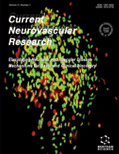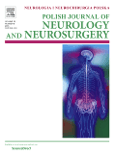
CURRENT NEUROVASCULAR RESEARCH
Scope & Guideline
Pioneering Research in Cellular and Molecular Neuroscience
Introduction
Aims and Scopes
- Neurovascular Pathophysiology:
Investigating the mechanisms underlying neurovascular diseases, including ischemic stroke, hemorrhagic stroke, and neurodegenerative disorders. This includes understanding the cellular and molecular pathways involved in neuronal injury and recovery. - Clinical Neurology and Interventions:
Exploring clinical outcomes and efficacy of various interventions, such as endovascular treatments, thrombolysis, and rehabilitation strategies in patients with acute neurovascular events. - Emerging Therapeutic Approaches:
Focusing on novel therapeutic strategies, including pharmacological treatments, stem cell therapies, and alternative medicine approaches like acupuncture in managing neurovascular conditions. - Predictive Models and Biomarkers:
Developing nomograms and predictive models for assessing patient outcomes, identifying biomarkers associated with prognosis, and understanding risk factors for neurovascular diseases. - Neuroimaging and Diagnostic Techniques:
Utilizing advanced imaging techniques for better diagnosis and understanding of cerebral conditions, including MRI, CT perfusion, and diffusion-weighted imaging.
Trending and Emerging
- Neuroinflammation and Immune Response:
An increasing number of studies are focusing on the role of neuroinflammation in neurovascular diseases, exploring mechanisms by which immune responses contribute to pathology and recovery. - Circadian Rhythms and Neurological Outcomes:
Research exploring the impact of circadian rhythms on neurovascular health and recovery is gaining traction, indicating a growing recognition of the importance of biological timing in patient outcomes. - Personalized and Targeted Therapies:
There is a notable trend towards personalized medicine approaches, utilizing genetic and metabolic profiles to guide treatment strategies in conditions like multiple sclerosis and stroke. - Gut-Brain Axis and Microbiota Influence:
Emerging studies are investigating the relationship between gut microbiota and neurovascular health, highlighting the potential role of the microbiome in influencing neurological diseases. - Innovative Rehabilitation Techniques:
Research into novel rehabilitation techniques, including the use of electroacupuncture and functional electrical stimulation, is on the rise, emphasizing the importance of comprehensive recovery strategies post-stroke.
Declining or Waning
- Traditional Pharmacological Approaches:
Research focusing solely on traditional pharmacological treatments for neurovascular diseases has seen a decrease, likely due to the increasing interest in personalized medicine and combination therapies that integrate multiple treatment modalities. - Basic Science Studies in Isolation:
There is a noticeable decline in studies that focus purely on basic science without translational or clinical implications. This shift emphasizes the journal's growing focus on research that bridges basic science with clinical outcomes. - Single-Factor Risk Assessments:
Publications dedicated to single-factor assessments of stroke risk or outcomes are becoming less common, reflecting a trend towards more comprehensive, multi-factorial analyses that consider a broader range of influences on neurovascular health.
Similar Journals

Neurotrauma Reports
Bridging knowledge gaps in neuroscience.Neurotrauma Reports, published by MARY ANN LIEBERT, INC, stands at the forefront of disseminating pivotal research within the evolving field of neuroscience. With an emphasis on both cellular and molecular neuroscience and developmental neuroscience, this open access journal, initiated in 2020, aims to bridge gaps in knowledge concerning neurotrauma, a critical area impacting brain health and recovery. Although currently positioned in the lower quartiles as per the 2023 category rankings, the journal provides invaluable insights that foster academic dialogue and collaboration among researchers, professionals, and students alike. Through its commitment to open access, Neurotrauma Reports ensures that cutting-edge research is accessible to a diverse audience, enhancing the visibility of emerging studies and fostering innovation within the field. Readers can explore this journal to stay updated with the latest findings, methodologies, and reviews that are shaping our understanding of neurotrauma, ultimately contributing to improved treatments and outcomes.

Revista Mexicana de Neurociencia
Fostering Interdisciplinary Insights in NeurologyThe Revista Mexicana de Neurociencia, published by the ACAD MEXICANA NEUROLOGIA, serves as a pivotal platform for the dissemination of research within the field of neurology and neuroscience. Although it was active from 2008 to 2014 and is no longer covered in Scopus, the journal still holds a significant place in the academic community, addressing critical topics relevant to both clinical and experimental neurology. With an emphasis on advancing knowledge in neuropsychology and public health, this journal targets researchers, professionals, and students alike, fostering an interdisciplinary dialogue that can enhance the understanding of neurological conditions within Mexico and beyond. As it stands, the journal is not open access, which may present challenges for accessibility, yet its affiliation with recognized academic standards underlines its commitment to quality research. This platform once provided insights that can inform practice and stimulate innovative approaches in the management of neurological disorders, underscoring its importance in the evolving landscape of neuroscience.

RESTORATIVE NEUROLOGY AND NEUROSCIENCE
Exploring Therapeutic Frontiers: Where Neurology Meets NeuroscienceRESTORATIVE NEUROLOGY AND NEUROSCIENCE, published by IOS PRESS, is a premier journal dedicated to advancing the fields of neurology and neuroscience. Since its inception in 1989, this journal has played a crucial role in disseminating cutting-edge research findings and innovative therapeutic approaches that aim to restore neurological function and improve patient outcomes. With a focus on developmental neuroscience and clinical neurology, the journal holds a 2023 Scopus ranking of #129 out of 400 in clinical neurology, and #15 out of 37 in developmental neuroscience, reflecting its significant influence in these domains. Although it operates on a non-open access model, RESTORATIVE NEUROLOGY AND NEUROSCIENCE offers valuable insights for researchers, healthcare professionals, and students seeking to deepen their understanding of neural restoration mechanisms and therapeutic strategies. Located in Amsterdam, Netherlands, the journal continues to foster scholarly dialogue and innovation, contributing to the global advancement of neuroscience and neurology.

NEUROBIOLOGY OF DISEASE
Decoding the Complexities of the Nervous SystemNEUROBIOLOGY OF DISEASE is a premier journal dedicated to advancing the understanding of neurological disorders and the underlying biological processes, published by Academic Press Inc, Elsevier Science. With an impressive impact factor indicative of its significance—ranked in the Q1 quartile in Neurology for 2023 and occupying the 14th rank out of 192 journals in the field of Neuroscience and Neurology—this journal serves as a critical resource for researchers, clinicians, and students alike. The journal has a rich history since its inception in 1994, continuously evolving its scope to encompass groundbreaking research and insights into neurobiological mechanisms and disease pathology. Though it currently does not provide Open Access options, NEUROBIOLOGY OF DISEASE remains a vital vessel for disseminating knowledge that significantly contributes to the field of neurology, fostering an understanding that can lead to innovative therapeutic strategies.

Turkish Neurosurgery
Pioneering Research for Tomorrow's NeurosurgeonsTurkish Neurosurgery is a distinguished journal published by the TURKISH NEUROSURGICAL SOC, dedicated to advancing the field of neurosurgery and clinical neurology. With an ISSN of 1019-5149 and converging its focus from 1990 to 2024, this regional journal aims to bridge the gap in knowledge dissemination within Turkey and beyond. It holds a notable position in the academic community, categorized in the Q3 quartile for both Neurology (clinical) and Surgery in 2023, illustrating its relevance in these critical fields. Although currently not an open-access publication, it offers insights and research findings that are vital for researchers, practitioners, and students who seek to stay abreast of developments in neurosurgical practices. Located in Ankara, Turkiye, Turkish Neurosurgery provides a platform for sharing rigorous research that enhances clinical outcomes and informs surgical techniques, thus playing a crucial role in elevating the standards of neurosurgery in the region.

Basic and Clinical Neuroscience
Fostering collaboration to tackle complex neurological challenges.Basic and Clinical Neuroscience, published by Iran University of Medical Sciences, is a distinguished open-access journal that has been operational since 2009, providing a platform for the dissemination of significant research in the fields of neuroscience and neurology. With the ISSN 2008-126X and E-ISSN 2228-7442, this journal serves as a vital resource for researchers, clinicians, and students by facilitating access to the latest findings and advancements in cellular and molecular neuroscience as well as clinical neurology. Although currently rated in Q4 for Cellular and Molecular Neuroscience and Q3 for Clinical Neurology as of 2023, it aims to enhance its standing through the publication of high-quality, peer-reviewed research. The journal has achieved a Scopus rank placing it in the 38th percentile for Neurology and the 13th percentile for Neuroscience, indicating a growing recognition of its contributions. With its commitment to open access, Basic and Clinical Neuroscience not only contributes to the scientific community in Iran but also strives to connect researchers worldwide, fostering collaborative efforts in tackling complex neurological challenges.

Journal of Stroke
Connecting Researchers and Clinicians for Stroke ProgressJournal of Stroke is a premier open-access journal published by the Korean Stroke Society, dedicated to advancing the understanding of stroke through cutting-edge research and innovative clinical practices. Since its inception in 2013, the journal has gained notable recognition in the fields of Cardiology and Cardiovascular Medicine and Neurology, reflecting its commitment to high-quality, peer-reviewed content, with rankings in the top quartiles (Q1) for both categories as of 2023. The journal’s impact is underscored by its Scopus rankings, placing it in the 92nd and 91st percentiles within its respective fields, thus serving as a vital resource for researchers, clinicians, and students seeking to enhance their knowledge and contribute to stroke research and treatment methodologies. The Journal of Stroke is strategically positioned in South Korea and fosters a global dialogue on stroke-related issues, reinforcing its role as a pivotal platform for disseminating vital findings that can influence both clinical practices and health policy.

Neurologia i Neurochirurgia Polska
Fostering Dialogue in Neurological SciencesNeurologia i Neurochirurgia Polska is a prestigious Polish journal dedicated to advancements in the fields of neurology and neurosurgery, published by VIA MEDICA. With a rich history dating back to 1967, this journal serves as a critical platform for disseminating significant research findings and clinical practices that advance our understanding of neurological disorders and surgical interventions. Registered under ISSN 0028-3843 and E-ISSN 1897-4260, it boasts commendable rankings as reflected in its 2023 categorical quartiles: Q3 in Neurology (Clinical) and Q2 in Surgery, indicating its substantial impact within these domains. Furthermore, its Scopus rankings reveal that it is positioned at Rank #125/551 within Medicine-Surgery and Rank #187/400 in Medicine-Neurology (Clinical), showcasing its importance in academic and clinical circles. Although not currently open access, the journal remains accessible to readers and practitioners who seek to stay updated on innovative research and methodologies. The journal’s objective is to foster knowledge exchange and stimulate scientific dialogue among researchers, professionals, and students, thus shaping the future of neurology and neurosurgery in Poland and beyond. Located at UL SWIETOKRZYSKA 73, 80-180 GDANSK, POLAND, it invites contributions that inspire and elevate the standards of medical practice.

INTERVENTIONAL NEURORADIOLOGY
Elevating Clinical Practice with Expert InsightsINTERVENTIONAL NEURORADIOLOGY, published by SAGE PUBLICATIONS INC, is a key journal within the interdisciplinary fields of cardiology, neurology, and radiology, focusing on the latest advancements and clinical practices in neuroradiology. With an ISSN of 1591-0199 and an E-ISSN of 2385-2011, this journal has established itself as a vital resource since its inception in 1996, attracting contributions from leading experts worldwide. Currently categorized in the Q2 category for Cardiology and Cardiovascular Medicine and Radiology, and Q3 for Clinical Neurology as of 2023, INTERVENTIONAL NEURORADIOLOGY has gained recognition for its impactful research, reflected in its ranking within the Scopus metrics. Although not an open-access publication, its rigorous peer-reviewed articles provide indispensable knowledge that enhances the practice and understanding of interventional procedures. Researchers, clinicians, and students will find this journal a valuable avenue for insights into the evolving landscape of neuroradiological interventions, ultimately contributing to improved patient outcomes.

ASN Neuro
Championing High-Impact Research in Neurology and NeuroscienceASN Neuro is an esteemed academic journal published by Frontiers Media SA, focusing on critical advancements in the fields of neurology and neuroscience. Since its inception in 2009, it has established itself as an Open Access platform dedicated to fostering the dissemination of knowledge and research findings that address the complexities of the nervous system. With an impressive impact factor and consistently ranking in the top quartiles of its categories—Q1 in Neurology (clinical) and Q2 in Neuroscience (miscellaneous)—ASN Neuro is recognized for its high-quality publications that cater to the evolving challenges in clinical neurology and general neuroscience. Currently, it ranks 68th out of 400 journals in Clinical Neurology and 28th out of 113 in General Neuroscience, affirming its reputable position within the academic community. Researchers, professionals, and students alike are encouraged to contribute to and benefit from this impactful journal as it presents a unique opportunity to engage with cutting-edge research, innovative methodologies, and insightful reviews in the ever-evolving landscape of brain science.